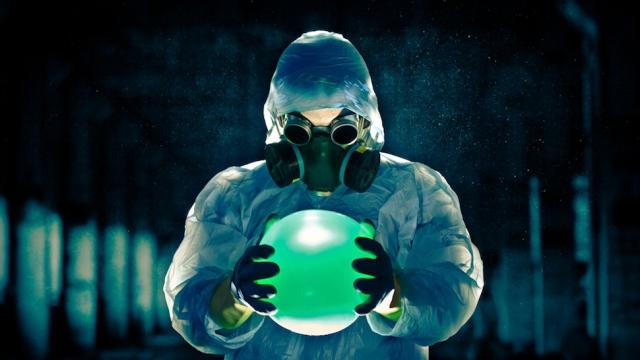Nuclear physics is a forbidding subject, even to trained physicists. To understand current news and discussions about nuclear science and technology, some background knowledge is required, and the high school science picture of the atomic nucleus as a tiny ball of protons and neutrons needs more refinement. Here are the basics.
This post is a continuation of RealClearScience’s series, Nuclear Physics 101.
What are isotopes?
Nuclear radiation alters a nucleus’ shape and size. It transforms nuclei of one type, or isotope, to another. Isotopes vary from one another by the number of neutrons they contain, and they are described with two numbers.
Atomic mass number (denoted A) is the count of both protons and neutrons in the atom, while atomic number (denoted Z) is the number of protons. Therefore, carbon-12 (A=12, Z=6) has six protons and six neutrons, carbon 13 (A=13, Z=6) has seven neutrons, and carbon 14 (A=14, Z=6) has eight neutrons. For chemists, the number of neutrons in a nucleus is nearly irrelevant. Molecular structure and chemical reactions are almost completely determined by electron configuration. Carbon 12,13 or 14 can all fit equally well into the organic molecules that life is made of.
The number of neutrons in the nucleus, however, is very important for nuclear reactions and processes studied in physics. Natural uranium is 99 per cent U-238, meaning 146 neutrons and 92 protons. The uranium needed for most reactor fuel is U-235 (with 143 neutrons), an isotope which makes up less than 1 per cent of natural U. Similarly, plutonium-238 is used to power space craft and plutonium-239 is utilised for reactor fuel and atomic weapons, but Pu-240 is useless for either task and is considered a contaminant in Pu-239 samples.
How do radioactive processes work?
Radioactivity is a phenomenon that, to be described, requires the complicated picture of quarks and nuclear strong and weak forces. The most common radioactive processes are alpha, beta, and gamma and neutron radiation.
Alpha radiation occurs when the nucleus expels a group of two protons and two neutrons, called an alpha particle (a helium nucleus with no electrons). For example, U-238 (Z=92) becomes thorium-234 (Z=90), ejecting the alpha particle helium-4 (Z=2). This happens for some very complicated reasons.
Quantum mechanical tunnelling can allow the alpha particle to occasionally move far enough away from the nucleus to weaken the grip of the strong force. When this happens, the electromagnetic repulsion between the positive nucleus and positive alpha particle shoots the particle out of the nucleus at 1/20 the speed of light, nearly 34 million miles per hour. This is known to occur only in elements heavier than Te-105.
Beta radiation is an even stranger process. Here is where the weak force comes in. When a nucleus has a large overabundance of one nucleon, the weak force allows up (u) and down (d) quarks to switch, so that an excess neutron can change into a proton (udd becomes uud), or a proton can change into a neutron (uud to udd)! In the former case, an electron and an anti-neutrino are emitted, and in the latter case, a positron (anti-electron with positive charge) and a neutrino are emitted. These extra particles produced in the process keep charge from being created or destroyed; they are ejected from the nucleus at speeds ranging from roughly zero to nearly the speed of light.
An example of beta decay would be carbon-14 (Z=6, 8 neutrons) becoming nitrogen-14 (Z=7, 7 neutrons) and emitting an electron and an anti-neutrino. This process (as well as alpha decay) is almost like some sort of alchemy, transmuting one element into another.
Gamma radiation is relatively simple in contrast to alpha and beta. Much like how an atom emits light when its electrons drop from a higher energy orbital to a lower energy orbital, it also emits light when the nucleus drops from a higher energy state to a lower one. The difference is that a nucleus contains far more energy than an electron, so it emits gamma rays, which are far more powerful than the typical ultraviolet or visible light emitted by electron energy changes. Gamma decay occurs directly after alpha and beta decay, as these processes leave the nucleus in one of its higher energy states.
Neutron radiation is produced by an active nuclear fission process, either by spontaneous fission or by a man-made device such as a nuclear weapon or reactor. We will discuss this later.
Should we be concerned?
Alpha radiation only harms people if they swallow an emitting source; alpha particles don’t have enough energy to penetrate the skin on their own. Beta radiation is not commonly a health concern. It too usually does not penetrate through the skin, but in high doses, it can cause severe burns. Gamma and neutron radiation, however, are far more dangerous. Gamma rays and neutrons both carry a large amount of energy and are capable of penetrating deep into the body and ionising and destroying atoms in its cells. This can cause DNA damage leading to cancer or even death in extreme cases.
Nuclear radiation is scary for a very understandable reason: It is a silent, mostly invisible killer. But, remember, most sources of radioactivity pose very little danger. Thus, understanding is the key to dispelling fear.
Picture: Shutterstock/Pindyurin Vasily
RealClearScience is your portal to the best, most relevant science stories from around the globe. In addition to daily curated aggregation of news articles, university press releases and videos, the site features a plethora of unique, original content, which can be found on the Newton Blog and in the Journal Club. Republished with permission.
